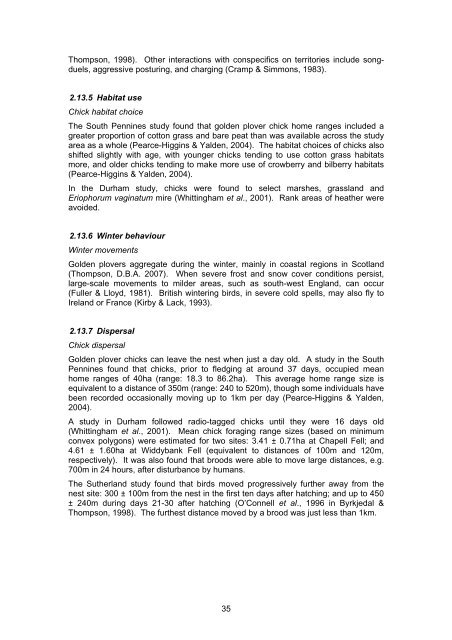Literature review to assess bird species connectivity to Special ...
Literature review to assess bird species connectivity to Special ...
Literature review to assess bird species connectivity to Special ...
You also want an ePaper? Increase the reach of your titles
YUMPU automatically turns print PDFs into web optimized ePapers that Google loves.
Thompson, 1998). Other interactions with conspecifics on terri<strong>to</strong>ries include songduels,<br />
aggressive posturing, and charging (Cramp & Simmons, 1983).<br />
2.13.5 Habitat use<br />
Chick habitat choice<br />
The South Pennines study found that golden plover chick home ranges included a<br />
greater proportion of cot<strong>to</strong>n grass and bare peat than was available across the study<br />
area as a whole (Pearce-Higgins & Yalden, 2004). The habitat choices of chicks also<br />
shifted slightly with age, with younger chicks tending <strong>to</strong> use cot<strong>to</strong>n grass habitats<br />
more, and older chicks tending <strong>to</strong> make more use of crowberry and bilberry habitats<br />
(Pearce-Higgins & Yalden, 2004).<br />
In the Durham study, chicks were found <strong>to</strong> select marshes, grassland and<br />
Eriophorum vaginatum mire (Whittingham et al., 2001). Rank areas of heather were<br />
avoided.<br />
2.13.6 Winter behaviour<br />
Winter movements<br />
Golden plovers aggregate during the winter, mainly in coastal regions in Scotland<br />
(Thompson, D.B.A. 2007). When severe frost and snow cover conditions persist,<br />
large-scale movements <strong>to</strong> milder areas, such as south-west England, can occur<br />
(Fuller & Lloyd, 1981). British wintering <strong>bird</strong>s, in severe cold spells, may also fly <strong>to</strong><br />
Ireland or France (Kirby & Lack, 1993).<br />
2.13.7 Dispersal<br />
Chick dispersal<br />
Golden plover chicks can leave the nest when just a day old. A study in the South<br />
Pennines found that chicks, prior <strong>to</strong> fledging at around 37 days, occupied mean<br />
home ranges of 40ha (range: 18.3 <strong>to</strong> 86.2ha). This average home range size is<br />
equivalent <strong>to</strong> a distance of 350m (range: 240 <strong>to</strong> 520m), though some individuals have<br />
been recorded occasionally moving up <strong>to</strong> 1km per day (Pearce-Higgins & Yalden,<br />
2004).<br />
A study in Durham followed radio-tagged chicks until they were 16 days old<br />
(Whittingham et al., 2001). Mean chick foraging range sizes (based on minimum<br />
convex polygons) were estimated for two sites: 3.41 ± 0.71ha at Chapell Fell; and<br />
4.61 ± 1.60ha at Widdybank Fell (equivalent <strong>to</strong> distances of 100m and 120m,<br />
respectively). It was also found that broods were able <strong>to</strong> move large distances, e.g.<br />
700m in 24 hours, after disturbance by humans.<br />
The Sutherland study found that <strong>bird</strong>s moved progressively further away from the<br />
nest site: 300 ± 100m from the nest in the first ten days after hatching; and up <strong>to</strong> 450<br />
± 240m during days 21-30 after hatching (O’Connell et al., 1996 in Byrkjedal &<br />
Thompson, 1998). The furthest distance moved by a brood was just less than 1km.<br />
35

















